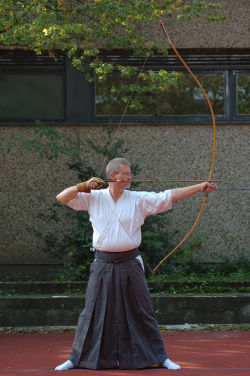Kyūdō (弓道:きゅうどう, Kyūdō?), literally meaning “way of the bow”, is the Japanese art of archery. It is a modern Japanese martial art (gendai budō).
It is estimated that there are approximately half a million practitioners of kyūdō today. Kyūdō is a rare sport in the sense that it is not dependant on age or sex. If the practitioner is dedicated, male or female, they can learn at any age. It’s never too early or too late to learn Kyūdō. Although one could learn Kyūdō at any point in their life, it can take a lifetime to perfect.
In its most pure form, kyūdō is practiced as an art and as a means of moral and spiritual development. Many archers practice kyūdō as a sport, with marksmanship being paramount. However, the goal most devotees of kyūdō seek is seisha seichu, “correct shooting is correct hitting”. In kyūdō the unique action of expansion (nobiai) that results in a natural release, is strived for. When the spirit and balance of the shooting is correct the result will be for the arrow to arrive in the target. To give oneself completely to the shooting is the spiritual goal. In this respect, many kyūdō practitioners believe that competition, examination, and any opportunity that places the archer in this uncompromising situation is important, while other practitioners will avoid competitions or examinations of any kind.
Kyudo is practised in different schools and styles and even between dojos of the same style the form of practice can vary. For joint practice, competition and graduation between different styles a standard form was prepared in 1953 by the Japanese Kyūdō federation as (kyūdō kyūhōn). Here however is an example of a practice session with a form different from kyūdō kyūhōn.
A practitioner will begin with seiza (traditional sitting position) followed by mokuso (meditation).
The practitioner may shoot at a specially designed straw target called makiwara (not to be confused with makiwara used in karate). The makiwara is shot at from a very close range (about seven feet, or the length of the archer’s strung yumi when held horizontally from the centerline of his body). Because the target is so close and the shot most certainly will hit, the archer can concentrate on refining his technique rather than on worrying about where the arrow will go.
After warming up, the archer may then move on to shooting at a target called a mato. Mato sizes and shooting distances vary, but most mato typically measure thirty-six centimeters (or 12 sun, a traditional Japanese measurement equivalent to approximately 3.03 cm) in diameter and are shot at from a distance of twenty-eight meters. However, depending on the practitioners skill level, they may be asked to shoot from half or three-quarters distance.
Typically the first round of shooters will fire two arrows in seated practice (zasha) before shooting from the standing position (risha)
The yumi (Japanese bow) is exceptionally tall (standing over two meters), surpassing the height of the archer (kyūdōka). Yumi are traditionally made of bamboo, wood and leather using techniques which have not changed for centuries, although some archers (particularly, those new to the art) may use synthetic (i.e. laminated wood coated with glassfiber or carbon fiber) yumi. Even advanced kyūdōka may own non-bamboo yumi and ya due to the vulnerability of bamboo equipment to extreme climates. The suitable height for yumi depends from the length of archers draw (yatsuka) which is usually about half the archers height.
Ya (arrow) shafts were traditionally made of bamboo, with either eagle or hawk feathers. Most ya shafts today are still made of bamboo (although some archers will use shafts made of aluminum or carbon fibers), and ya feathers are now obtained from non-endangered birds such as turkeys or swans. The length of an arrow is the archers yatsuka plus between 6 to 10 centimeters. Every ya has a gender (male ya are called haya; female ya, otoya); being made from feathers from alternate sides of the bird, the haya spins clockwise upon release while the otoya spins counter-clockwise. Kyūdō archers usually shoot two ya per round, with the haya being shot first. It is often claimed that the alternate spinning direction of the arrows would prevent two consecutive identically shot arrows from flying identically and thus colliding.
The kyūdō archer wears a glove on the right hand called a yugake. There are many varieties of yugake, they are typically made of deerskin. Practitioners can choose between a hard glove (with a hardened thumb) or a soft glove (without a hardened thumb), there are different advantages to both.
With a hard glove, the thumb area is not very flexible and has a pre-made groove used to pull the string (tsuru). With a soft glove, the thumb area is very flexible and is without a pre-made groove, allowing the practitioner to create their own, based on their own shooting habits.
Typically a yugake will be of the three or four finger variety. The amount of fingers on the glove is dependent on the school of kyudo and the weight of the bow being pulled. Three finger yugake are usually used with bows below 20 pounds, while four finger yugake are used with bows above 20 pounds. Though rare, it is not unheard of for archers to use one finger or five finger gloves. Some schools, such as Heki-ryū Insai-ha only use the three fingered glove, even with bows above 40 pounds. A practitioners knock and grip of the arrow can be dictated by the glove and bow they are using. It is not uncommon for practitioners who have upgraded or downgraded bow weight to continue to use the same glove and not change.


Leave a reply to Kyudo